


Corundum Information & Sapphire Information
Enter our Virtual Gallery of Red Corundum Specimens
(variety: Ruby Mineral Specimens)
or, see our entire selection of
Natural Sapphire Jewelry Items
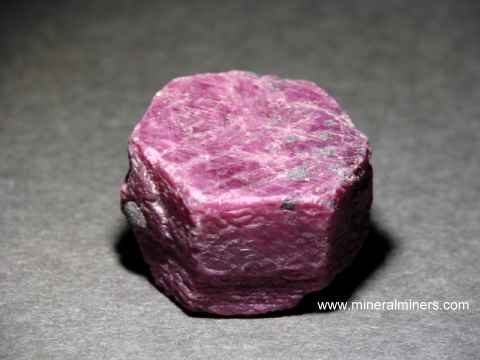
Links To Corundum Mineral Information Topics On This Page:
Corundum Varieties And Items in our VIRTUAL GALLERY
Corundum Physical Properties
Corundum Background Information
Corundum Geologic Occurance and Diagnostic Features
Corundum Historical Information, Meaning and Uses
Corundum Metaphysical Properties
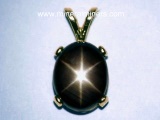 |
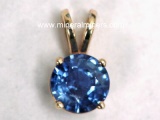 |
 |
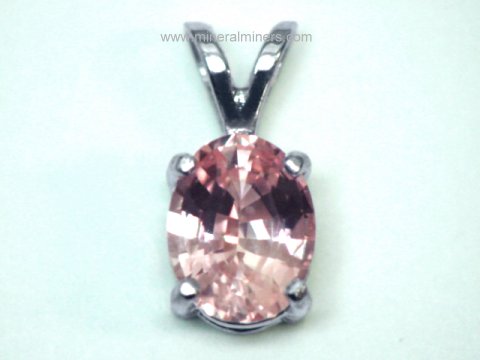 |
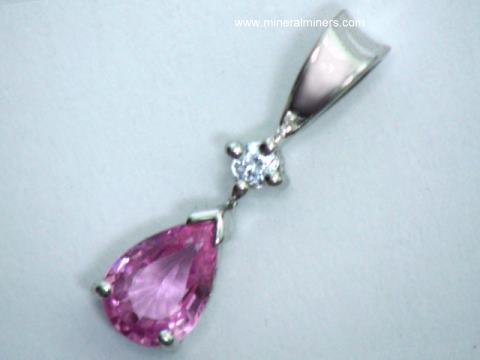
|
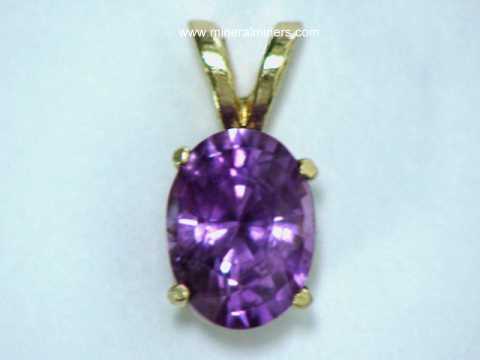
|
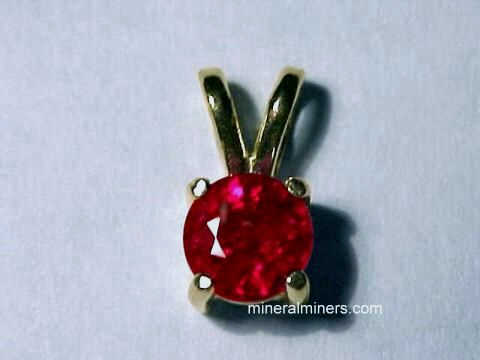 |

|
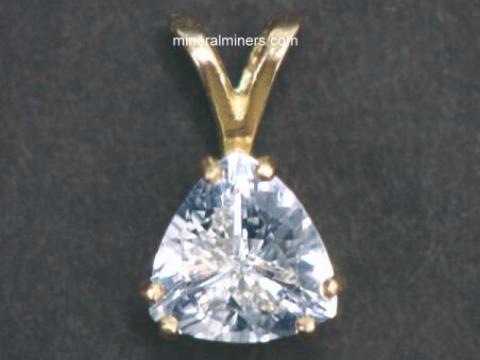 |
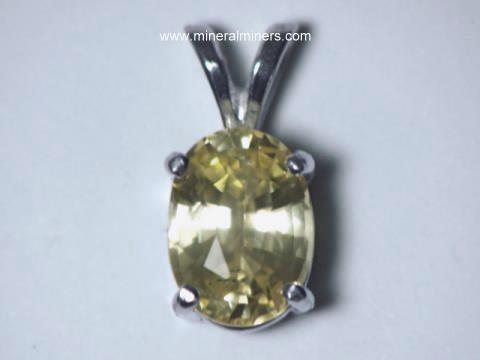 |
Pure colorless corundum (Al2O3) is rare in nature. Small amounts of metalic elements typically substitute for
aluminum in the corundum crystal structure, giving rise to the many color variations seen in natural corundum.
Blue Sapphire Information
Gem corundum of any color is refered to as sapphire with a preceeding color
designation if the color is any other than blue. Blue corundum is simply
called sapphire. The color in blue sapphire is due to trace amounts of titanium impurities substituting fpr aluminum in the corundum crystal structure. There are two other color varieties of corundum that
have specific names, the pinkish-red to red ruby and the pinkish-orange padparadscha.
The famous pinkish-red to red ruby owes its color to chromium (Cr3+) impurities, and the color of the rare orangish-pink padparadscha sapphire is from both iron and chromium impurities. The color of the well known blue sapphire (or simply sapphire) is due to Fe2+ and Ti4+ impurities. Iron in the Fe3+ state causes the color in some yellow sapphires, while other yellow sapphires owe their color to irradiation induced 'color centers'. Other color influencing impurities in sapphires are vanadium, cobalt and nickel.
Some sapphires owe their color to 'color centers' which are not fully understood, but it can be said that they are created by radiation and destroyed (reversed) by heating or in some cases by exposure to light. Some color centers in sapphire are stable until heated hundreds of degrees while others are very unstable, fading within a few days merely by exposure to light.
The color and in some cases the clarity in gem corundum can be modified by a number of processes that are in common use today. Most of these processes involve heating, often in the presence of specific chemical ingredients, in order to intensify a natural color or sometimes to introduce an entirely different color altogether. Many light gray to pale blue gem corundums with a 'silky' look due to microscopic titanium oxide inclusions are heated to near their melting point, resulting in the dissolution of the silk-causing inclusions producing a more transparent gem. This improvement in clarity is often accompanied by a much stronger deep blue color as well.
Gem corundum that exhibits natural color and clarity commands a significant price premium over comparable artificially enhanced corundum of natural origin. Determining whether a natural gem corundum has been artificially enhanced can be very difficult and is quite often impossible with the naked eye alone. Special techniques and equipment are usually neccessary, and even then some doubts can remain.
Some corundum occurs with minute rutile inclusions oriented at an angle of 120 degrees from each other according to the hexagonal symmetry of the corundum. If the concentration of rutile fibers is sufficiently dense, then when this material is fashioned into a cabochon gem with the c axis of the corundum perpendicular to the base of the stone, reflected light from the rutile inclusions can concentrate on the surface of the gem forming white lines that intersect every 60 degrees forming a six ray star. This material is known as star ruby if it is pinkish-red to red, or as star sapphire with a color prefix for all other colors other than blue. Blue star corundum is simply called star sapphire. Most synthetically produced star corundum has very perfect stars with fine straight rays. Natural star corundum characteristically has some imperfections (if it looks too good to be true...), although occaisionally a natural star corundum does occur with an exceptionally fine quality near-perfect star.
Corundum occurs in a variety of geological settings, characteristically in aluminum-rich and silica-poor rocks. It often occurs as an accessory mineral in metamorphic rocks derived from aluminous or carbonate sediments such as crystalline limestones and marbles, mica schists and gneisses. It is also found in contact zones between igneous rocks and limestones.
Corundum also appears in silica-poor light colored igneous rocks such as desilicated pegmatites, syenites and nepheline syenites.
Due to its high hardness and chemical inertness, corundum is often encountered in eluvial and alluvial deposits.
Corundum is characterized by its high hardness, luster and specific gravity, and its color and habit.
The name corundum was derived either from the Sanskrit kurivinda or from the
Indian name for corundum kauruntaka. Ruby is from the Latin word
ruber meaning red, and sapphire is from the Latin word for blue sapphirus,
which is also thought to have been used in ancient times in refering to lapis lazuli.
In ancient times, natural spinel gemstones were often confused with natural corundum.
Ruby and sapphire are among the oldest gems known to man, dating back many thousands of years. They were both held in very high regard, in particular the ruby. The ancient Sanskrit names for ruby translate as king of precious stones or leader of precious stones. Both ruby and sapphire were in the 'Breastplate of Judgement' of Aaron, described in the bible (Exodus: xxviii, 15-30).
Throughout history both ruby and sapphire have been attributed with having a great variety of beneficial properties. Ruby was said to preserve health and give invulnerability from wounds, and to guarantee that one's status and posessions would never be taken. The wearing of a ruby was said to signify manhood, nobility and valor in a man, and pride & passion in a woman. Sapphire was said to bring divine favor, to make peace between enemies and to protect against envy, fraud, poison and sorcery. The wearing of sapphire earrings or other genuine sapphire jewelry was said to signify generosity, good manners, wisdom and noble thoughts. Star sapphire was widely believed to serve as protecion against witchcraft or sorcery of any kind.
Corundum is used as a gemstone, occuring in all colors. Due to natural
corundum's popularity and high value, synthetically produced gem corundum
has been used as an inexpensive substitute for many years.
Corundum is also used as an abrasive. Corundum that has been synthetically
manufactured from bauxite is most often used for this purpose. The abrasive
material emery is a mixture of corundum and magnetite.
Ruby is the birthstone for the month of July.
Sapphire is the birthstone for the month of September.
Sapphire is the symbolic gemstone for the 23th wedding anniversary.
Star sapphire is the symbolic gemstone for the 26th wedding anniversary.
Ruby is the symbolic gemstone for the 40th wedding anniversary.
Star ruby is the symbolic gemstone for the 52nd wedding anniversary.
The astrological sign of corundum is Sagittarius.
The astrological signs of ruby are Leo, Scorpio, Cancer and Sagittarius.
The astrological signs of sapphire are Virgo, Libra and Sagittarius.
yellow sapphire gemstones are used with vedic astrology and jyotish.
Corundum is said to enhance one's creativity, self-confidence, awareness,
intuition and ambition. It is also said to help release negative emotions
in constructive ways while giving give inner peace.
Metaphysical properties for some of the corundum varieties are
given below:
Black sapphire: is said to protect one from physical harm
and enhance one's self-confidence.
Green sapphire: is said to strengthen loyalty and honesty. See our selection of natural green sapphire earrings!
Pink sapphire: is said to inspire love, and to enhance one's
creativity and self-reliance.
Purple sapphire: is said to aid in meditation, and to enhance
one's spirituality.
Ruby: is said to inspire love, and to enhance creativity, wisdom
and spirituality. It is also said to give confidence, self-esteem and courage,
and to stimulate leadership qualities. Ruby is also said to have been helpfull in
treating heart and circulatory disease. Visit our pages displaying genuine ruby earrings and ruby necklaces.
Sapphire (blue color): wearing blue sapphire jewelry is said to eliminate confusion, and to dissipate
negative emotions such as fear, hate and anger, replacing them with peace,
joy and love. It is said to enhance one's ability to communicate with
others. Sapphire is also said to have been helpfull in treating disorders of
the eyes and skin, and in stopping infections. Be sure to see our selection of natural blue sapphire necklaces!
Star sapphire: said to aid in meditation and to give mental
clarity and wisdom. It is also said to bring good fortune and to give one a
more pleasant disposition.
Yellow sapphire: is said to bring wisdom, wealth and prosperity.
White sapphire (colorless): is said to stimulate one's intellect
and to help focus one's concentration. It is also said to inspire fairness
and morality.
For more in-depth metaphysical information, see our Metaphysical Books section.
This is the end of our Corundum Factsheet and Corundum Information page.
Enter our Virtual Gallery of
Corundum (variety: Blue Sapphire) Mineral Specimens
Ruby Crystals and Mineral Specimens
Visit our Natural Star Sapphire Gemstones Page
Go back up to the Top of this Corundum Information Page